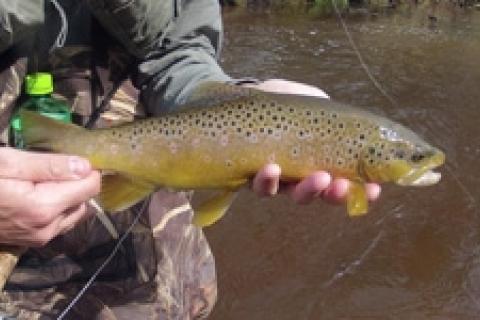
 As the leaves begin to turn and the weather gets colder people start to shift gears from fishing to hunting. Although this seems like a natural progression, you will be missing out on some of the best tributary fishing of the year. If you are lucky enough to live in an area that has a Great Lakes tributary flowing nearby then the fall fishing season needs to be on your calendar.
As the leaves begin to turn and the weather gets colder people start to shift gears from fishing to hunting. Although this seems like a natural progression, you will be missing out on some of the best tributary fishing of the year. If you are lucky enough to live in an area that has a Great Lakes tributary flowing nearby then the fall fishing season needs to be on your calendar.
Every year starting mid-August (depending on water levels) trout begin making their annual run up the river from the big lakes. Brown Trout enter the river system first (mid-August to early September) with hoards of steelhead and salmon to follow. Since these runs are water dependent in shallower streams you can bet that fish will be moving in the river after every good rainfall. The key to fall run fishing is finding where the fish are in the river system. Once you find a stretch with a few fish you can keep returning to the same area and catch good numbers until the group moves further upstream.
To start fishing fall run trout and salmon start low by the river mouth and work your way upriver. Fish will be more active and willing to bite in the early morning so getting on the river by sun-up is a must. Approach the river quietly and watch for fish moving about in the river. Lake run fish will hold in the usual spots that you find trout (outside corners on bends, downed timber, etc) but it seems early in the morning they prefer deep slow runs. Work these runs from the back of the run to front, inside edge out. If you are careful about the way that you fish a run you will be able to pick up several fish from one run.
The beauty of fall run fish is that they are not particular as to what they eat. Spinners, flies and natural baits all work well. Salmon and steelhead particularly like fast moving baits worked low in the water column and the browns eat just about anything that looks vulnerable. If you are fishing flies or spinners and you feel a tap while you are retrieving your bait, don't set the hook. Salmon will swing several times for your bait so just wait until you feel the weight setup on the line before setting the hook.
With the sheer size and numbers of fish that enter the river in the fall don't miss this opportunity to get a few last fish before the snow flies.
- 3114 views

